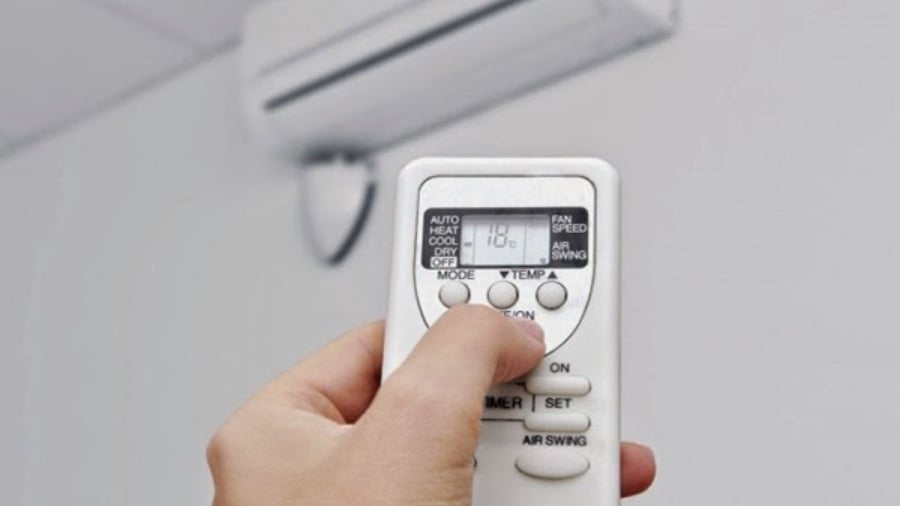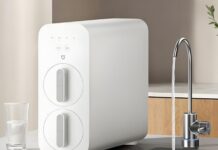During humid weather, the indoor air can become moist and uncomfortable. Many people tend to use the “Cool” mode on their air conditioners to alleviate the stuffy feeling. However, not many are aware that to effectively dry the air and reduce humidity, we should use the “Dry” mode on our air conditioners. This mode is usually indicated by a water droplet symbol on the control panel.

Few people know that to effectively dry the air and reduce humidity, we should use this mode.
What is the “Dry” mode and how does it work?
The “Dry” mode, also known as the dehumidifying mode, functions to reduce indoor humidity without significantly altering the temperature. When this mode is activated, the air conditioner runs the fan at a low speed and draws in moist air from the room into the evaporator. The moisture in the air condenses into water droplets due to the cold temperature, adhering to the evaporator, and is then directed outside through a drainage pipe. To prevent an icy blast of air, the air conditioner gently warms the dehumidified air before blowing it back into the room. This cycle repeats continuously to maintain humidity at around 60%, providing a comfortable and dry environment for occupants.
Advantages of the “Dry” mode
Reduces humidity and improves air quality: The “Dry” mode effectively eliminates excess moisture in the air, preventing mold and bacterial growth, reducing musty odors, and protecting the health of your family, especially children and the elderly.
Energy savings: Compared to using the standard cooling mode, the dehumidifying mode can save energy in certain situations, particularly when humidity levels are high. However, it is important to use it correctly to optimize energy efficiency.
Protects indoor items: Helps safeguard furniture, clothing, books, and other belongings from damage caused by dampness and mold.
Quiet operation: As the “Dry” mode does not produce cool air, the unit operates gently and quietly, ensuring a good night’s sleep.
Disadvantages of the “Dry” mode
Not suitable for all weather conditions: The “Dry” mode is typically used in environments with high humidity due to its dehumidifying capabilities. Therefore, consider avoiding it during dry weather.
Not recommended for prolonged use: Using the dehumidifying mode for extended periods can lead to overly dry air, causing skin dryness, chapped lips, and discomfort, especially for those with sensitive skin.
To use the “Dry” mode on your air conditioner, follow these steps:
Start the air conditioner: Press the ON/OFF button on the remote control to turn on the unit.
Select the “Dry” mode:
If your remote has a MODE button: Press the MODE button repeatedly until the “Dry” mode is displayed on the screen, indicated by a water droplet symbol.If your remote has a dedicated “Dry” button: Press the “Dry” button directly to activate the dehumidifying mode.To turn off the “Dry” mode, press the MODE button to switch to another mode or press the OFF button to turn off the air conditioner.
Notes when using the “Dry” mode
Use only when humidity is high: The “Dry” mode is most suitable during hot and humid weather (typically during rainy or humid seasons). Reducing humidity during these times can make you feel more comfortable without needing to lower the temperature significantly.
Avoid using during dry and hot weather: The “Dry” mode is not ideal during hot and dry weather as it lacks deep cooling capabilities. If the room temperature is too high, you may still feel uncomfortable even with the air conditioner turned on.
Do not overuse the “Dry” mode: Using the dehumidifying mode unnecessarily or in low-humidity environments can lead to wasted energy and cause skin and lip issues due to overly dry air.
In conclusion, to reduce humidity and create a dry and comfortable environment during humid weather, opt for the “Dry” mode on your air conditioner instead of the “Cool” mode. Using the appropriate mode not only enhances your comfort but also
The Magic Button: Mastering Your AC’s Secret Weapon for Massive Energy Savings
The average user only scratches the surface when it comes to utilizing their air conditioner remote controls. Beyond the basic on, off, and temperature adjustment buttons, there’s a whole host of features just waiting to be explored. It’s time to unlock the full potential of your AC and discover a whole new world of comfort and customization.






































